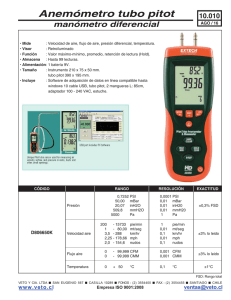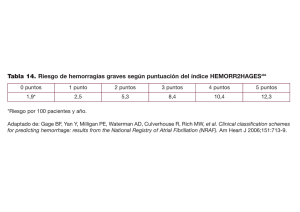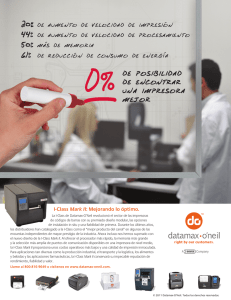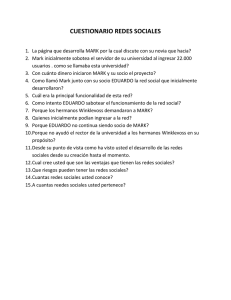DWYER INSTRUMENTS, INC. Phone: 219/879-8000
Anuncio
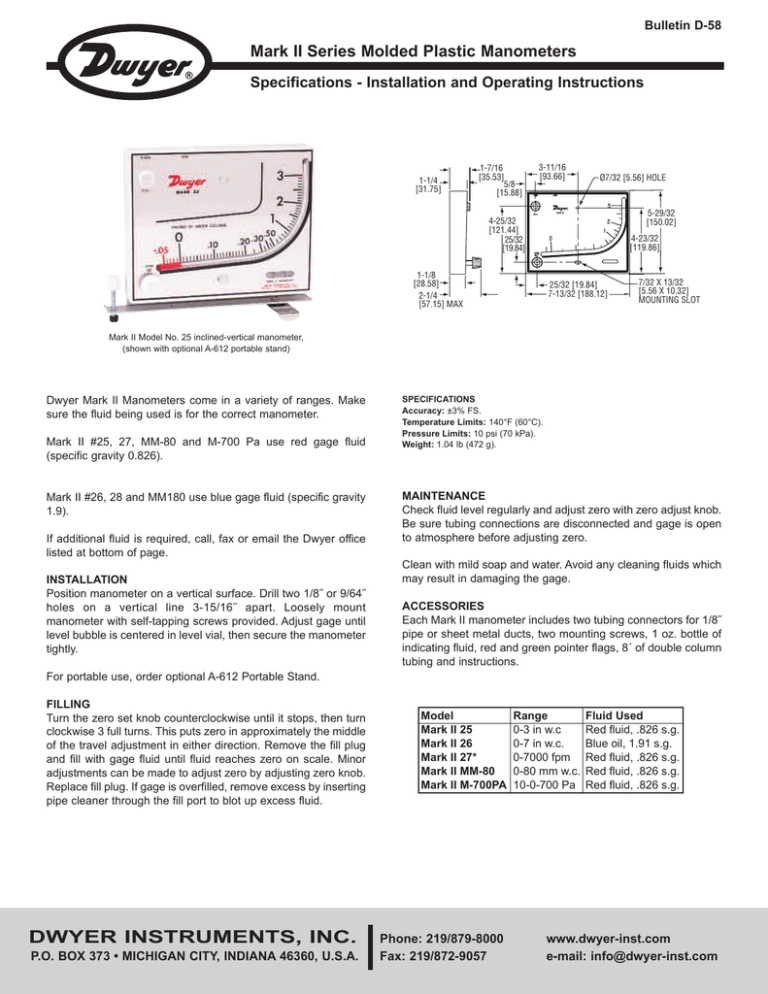
Bulletin D-58 Mark II Series Molded Plastic Manometers Specifications - Installation and Operating Instructions 1-1/4 [31.75] 1-7/16 [35.53] 5/8 [15.88] 3-11/16 [93.66] Ø7/32 [5.56] HOLE 5-29/32 [150.02] 4-25/32 [121.44] 25/32 [19.84] 1-1/8 [28.58] 2-1/4 [57.15] MAX 4-23/32 [119.86] 25/32 [19.84] 7-13/32 [188.12] 7/32 X 13/32 [5.56 X 10.32] MOUNTING SLOT Mark II Model No. 25 inclined-vertical manometer, (shown with optional A-612 portable stand) Dwyer Mark II Manometers come in a variety of ranges. Make sure the fluid being used is for the correct manometer. Mark II #25, 27, MM-80 and M-700 Pa use red gage fluid (specific gravity 0.826). Mark II #26, 28 and MM180 use blue gage fluid (specific gravity 1.9). If additional fluid is required, call, fax or email the Dwyer office listed at bottom of page. INSTALLATION Position manometer on a vertical surface. Drill two 1/8˝ or 9/64˝ holes on a vertical line 3-15/16˝ apart. Loosely mount manometer with self-tapping screws provided. Adjust gage until level bubble is centered in level vial, then secure the manometer tightly. SPECIFICATIONS Accuracy: ±3% FS. Temperature Limits: 140°F (60°C). Pressure Limits: 10 psi (70 kPa). Weight: 1.04 lb (472 g). MAINTENANCE Check fluid level regularly and adjust zero with zero adjust knob. Be sure tubing connections are disconnected and gage is open to atmosphere before adjusting zero. Clean with mild soap and water. Avoid any cleaning fluids which may result in damaging the gage. ACCESSORIES Each Mark II manometer includes two tubing connectors for 1/8˝ pipe or sheet metal ducts, two mounting screws, 1 oz. bottle of indicating fluid, red and green pointer flags, 8´ of double column tubing and instructions. For portable use, order optional A-612 Portable Stand. FILLING Turn the zero set knob counterclockwise until it stops, then turn clockwise 3 full turns. This puts zero in approximately the middle of the travel adjustment in either direction. Remove the fill plug and fill with gage fluid until fluid reaches zero on scale. Minor adjustments can be made to adjust zero by adjusting zero knob. Replace fill plug. If gage is overfilled, remove excess by inserting pipe cleaner through the fill port to blot up excess fluid. DWYER INSTRUMENTS, INC. P.O. BOX 373 • MICHIGAN CITY, INDIANA 46360, U.S.A. Model Mark II 25 Mark II 26 Mark II 27* Mark II MM-80 Mark II M-700PA Phone: 219/879-8000 Fax: 219/872-9057 Range 0-3 in w.c 0-7 in w.c. 0-7000 fpm 0-80 mm w.c. 10-0-700 Pa Fluid Used Red fluid, .826 s.g. Blue oil, 1.91 s.g. Red fluid, .826 s.g. Red fluid, .826 s.g. Red fluid, .826 s.g. www.dwyer-inst.com e-mail: info@dwyer-inst.com APPLICATIONS MARK II MANOMETER PITOT TUBE (SECTION ENLARGED TO SHOW DETAIL) Pt Ps FLOW AIR FILTER GAGE Mount gage within 3 ft. of filter bank. Install tubing adapters on each side of filter. Run tubing from clean side of filter to positive pressure side of gage (left fitting). Run downstream side to low pressure side of gage (right fitting). Install green and red arrows adjacent to indicating tube to indicate filter condition. AIR VELOCITY METER A pitot tube should be used for air velocity readings. Install the pitot tube and gage carefully to ensure accuracy. Select a location for the pitot tube with al least four diameters of smooth straight sections of duct both upstream and downstream. Install pitot tube in the center of duct with tip directed into air stream. Connect the right angle (leg parallel to tip) to negative (right fitting) and straight pitot tube connection to positive (left connection) of gage. The velocity reading shown on the gage is the center or maximum velocity. For average velocity across the full area, multiply by a factor of 0.9. No’s. 27 and 28 require pitot tube at additional cost. See Bulletin F-41-F. The velocity indicated is for dry air at 70°F, 29.9˝ barometric pressure and a resulting density of 0.075 lb/ft3. For variation from these standard conditions, corrections may be based upon the following data. PITOT TUBE SENSES TOTAL AND STATIC PRESSURES. MANOMETER MEASURES VELOCITY PRESSURE-(DIFFERENCE BETWEEN TOTAL AND STATIC PRESSURES). AIR VELOCITY CALCULATIONS: Air Velocity = 1096.2 √ PV D where Pv = velocity pressure in inches of water D = Air density in lb/ft3 Air Density = 1.325 x PB T where PB = Barometric Pressure in inches of mercury T = Absolute Temperature (indicated temperature °F plus 460) Flow in cu. ft. per min. = Duct area in square feet x air velocity in ft. per min. Bulletin D-58 Uso, Instalacion y Mantenimiento MANOMETROS DWYER MARK II RANGOS Modelo 25 26 M-80 M-180 M-700 Pa 27 * 28 * Rango 0~3˝ C.A. 0~7˝ C.A. 0~80 mm C.A. 0~180 mm C.A. 10~0~700 Pascal 0~7.000 pie./min. 0~10.500 pie./min. Fluido 0,826 rojo 1,9 azul 0,826 rojo 1,9 azul 0,826 rojo 0,826 rojo 1,9 azul *Los modelos 27 y 28 requieren tubo Pitot, con costo adicional. INSTALACION Instale el Mark II en una superficie vertical adecuada. El ambiente debe estar libre de vapores de sustancias cloradas, o solventes tales como benceno, acetona, tetracloruro de carbono, etc. El instrumento soporta presiones internas de hasta 10 PSI, o 0,703 bar, y temperaturas de hasta 140°F ó 60°C. NO EXCEDA ESTOS LÍMITES! Perfore dos orificios de 3,6 mm en línea vertical, separados por 100mm, e instale el instrumento con los tornillos autorroscantes provistos con él. Sin apretar demaslado, coloque el instrumento vertical con ayuda del nivel incluido en la parte inferior derecha del mismo. Verifique que ha quedado vertical y repita el proceso si es necesario. Para uso portable, use el soporte vertical tipo A612. LLENADO Gire en sentido antihorario la perilla de ajuste de cero hasta que se detenga; gírela nuevamente pero en sentido horario unas tres vueltas, de modo de dejar la posibilidad de ajuste en cualquier dirección. Retire el tapón de llenado y comience a llenar el manómetro lentamente hasta ver el líquido en las cercanías del cero de la escala. ATENCION: Use solamente fluido rojo de peso específico 0,826 para los modelos 25; 27; MM-80 y M-700Pa. Use solamente fluido azul de peso específico 1,9 para los modelos 26; 28 y MM-180. Adjuste exactamente el cero del instrumento girando la perilla según corresponda, y reponga el tapón de llenado. Si el ajuste preciso es imposible por exceso de llenado, retire nuevamente el tapón y extraiga el exceso introduciendo un limpiador de tubos, que absorba el exceso. Con el instrumento se suministra un tubo plástico flexible doble de 2,4 m juntamente con adaptadores para conexión a 1/8˝ NPT. Conecte el tubo marcado con una línea roja al la entrada de alta presión mas elevada a sensar. Repita el procedimiento con el tubo restante en la entrada de baja presión (LOW, a la derecha), y a la presión más baja a sensar. MANTENIMIENTO Verifique de tanto en tanto el nivel de fluido, y reajuste el cero del instrumento según sea necesario. Asegúrese de haber venteado el instrumento desconectando los tubos de conexión a proceso (entradas HIGH y LOW en la parte superior del manómetro). Agregue fluido solo si es necesario, utilizando los fluidos DWYER azul o rojo según corresponda. No utilice otros fluidos pues podrían dañar el material. Para limpieza use solo jabón neutro y agua, evitando solventes que puedan dañar el instrumento (vea Instalación). Limpie la perilla con un pincel pequeño y suave. APLICACIONES MARK II MANOMETER PITOT TUBE (SECTION ENLARGED TO SHOW DETAIL) Pt Ps FLOW PITOT TUBE SENSES TOTAL AND STATIC PRESSURES. MANOMETER MEASURES VELOCITY PRESSURE-(DIFFERENCE BETWEEN TOTAL AND STATIC PRESSURES). MEDICIÓN DE TIRO Instale un tubo de hierro de 1/8˝ (3,2 mm) o mayor desde el conducto a medir hasta una distancia de 1,5 m del instrumento. Use únicamente al conector derecho (LOW). Se debe prever la limpieza periódica para evitar acumulación de suciedad. INDICADOR DE PRESIÓN ESTÁTICA Tenga en cuenta que las velocidades de aire superiores a 100 fpm (5 m/seg.) son una fuente de posibles errores en la medición. Es conveniente usar sondas para presión estática. De no ser disponibles, ingrese las conexiones al conducto, en ángulo recto a la corriente de aire, y deles una terminación suave en los extremos. INDICADOR DE OBSTRUCCIÓN DE FILTROS Instale el manómetro a distancia no mayor de 1 m del banco filtrante. Conecte el lado de descarga del filtro al conector LOW en la parte superior del instrumento y el otro tubo,al conector HIGH y a la presión positiva. Retire el papel protector de la flechas autoadhesivas (roja y verde)y adhiéralas adyacentes al tubo indicador para marcar lecturas de filtro limpio y sucio. MEDICION DE VELOCIDAD DE AIRE EN CONDUCTOS Se requiere un tubo Pitot para esta aplicación. Instálelo bien centrado dentro del conducto, en una zona donde sea recto y sin obstrucciones por lo menos en distancias de 4 diámetros tanto corriente arriba como abajo del punto de inserción. Asegúrese que la punta del tubo Pitot está bien dirigida hacia la corriente de aire. Conecte el tubo doble a los conectores HIGH y LOW, de modo de conectar LOW al conector en ángulo recto del tubo Pitot, y el restante a HIGH. La velocidad leída es la máxima, correspondiente al centro del conducto. Para calcular la velocidad promedio multiplique por 0,9. Esta velocidad corresponde a aire seco, a 21°C a una presión de 760 mmHg y de una densidad de 0,075 /cuft. Para otras condiciones se deben aplicar factores de corrección de acuerdo a lo siguiente: CALCULO DE VELOCIDAD DE AIRE Velocidad de Aire =1096,2 √ (Pv/D) Donde Pv es la presión por velocidad en ˝ de C. Agua. D: densidad del aire en #/pie3 Densidad de aire = 1,325 X (Pb/T) Para PB: presión barométrica en ˝ de Mercurio, y T = Temperatura absoluta (°F+460) Caudal en pie3/min. = Area del conducto (pie2) X Veloc. de aire (pie/min.) ©Copyright 2013 Dwyer Instruments, Inc. Printed in U.S.A. 5/13 DWYER INSTRUMENTS, INC. P.O. BOX 373 • MICHIGAN CITY, INDIANA 46360, U.S.A. Phone: 219/879-8000 Fax: 219/872-9057 FR# 67-440215-00 Rev. 14 www.dwyer-inst.com e-mail: info@dwyer-inst.com

